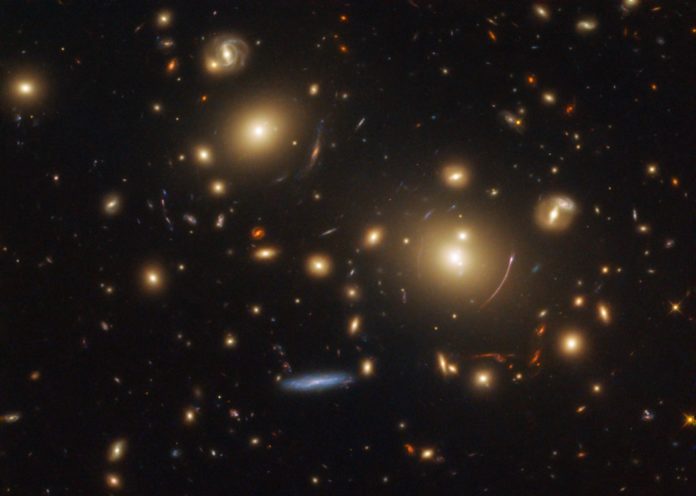For the first time ever, astronomers have managed to look nearly 10 billion years back in time to the earliest stages of star formation in X-ray light. They did it by taking advantage of a naturally-occurring magnifying glass located almost six billion light-years away from the Earth.
The research was carried out by an international collaboration including Julie Hlavacek-Larrondo, associate professor of physics and Canada Research Chair at the Université de Montréal, and was published in Nature Astronomy.
Natural magnifying glass for Universe’s earliest moments
How do astronomers peer back in time to the earliest epochs of the Universe? In this case, they made use of a technique known as gravitational lensing. Massive objects like galaxy clusters can bend the fabric of space-time, causing light from fainter, faraway objects in the background to become distorted on its way towards us.
This effect makes these background objects appear larger and brighter, and therefore easier to observe than they would have been otherwise.
What’s more, light takes time to travel towards us through space. This means that when we observe the light from very distant objects, we’re actually observing light that was emitted many years ago and spent many years travelling through outer space to reach our telescopes. In essence, we’re looking into the past.
In this study, the cosmic magnifying glass used to look back in time was an enormous galaxy cluster known as the Phoenix, which is estimated to be a quadrillion times more massive than the Sun. The team used the Phoenix cluster to magnify a distant, newborn galaxy about 1/10,000 the size of the Milky Way.
While this technique has previously been harnessed to study faraway astronomical phenomena in optical light, this was the first time it had been successfully used at X-ray wavelengths.
X-ray light is unique because it can be used to trace powerful, high-energy phenomena, including the births of supermassive short-lived stars entirely unlike those in our own solar neighbourhood. Observations of star-forming galaxies with X-ray light can therefore help astronomers answer questions about how the most massive stars in the Universe form, and what effects they may have on their environments.
“[We saw] this little blue smudge, meaning it’s a very small galaxy that contains a lot of super-hot, very massive young stars that formed recently,” said Matthew Bayliss, a research scientist at MIT’s Kavli Institute for Astrophysics and Space Research and lead author of the study, in a press release.
“This galaxy is similar to the very first galaxies that formed in the universe… the kind of which no one has ever seen in X-ray in the distant universe before.”
A new method to cut the glare to peer back in time
The reason this technique had never been carried out in X-ray light before is that galaxy clusters themselves emit large amounts of X-rays. Astronomers had assumed that any background X-rays being magnified by the large galaxy clusters would be hidden in the glare from the galaxy clusters’ own X-ray emission.
To address this, the team created a model of what they expected the Phoenix cluster’s X-ray emission to look like, based on observations taken in optical and infrared light. They used this model to subtract the X-rays originating from the Phoenix cluster, leaving only the magnified X-rays from the background source.
Their results are proof that galaxy clusters can be used to magnify distant X-rays and help shed light on some of the earliest periods in the history of the Universe.
“We’re catching this galaxy at a very useful stage, where it’s got these really young stars,” Bayliss said. “Now we can go back in time, look in the distant universe, find galaxies in this early phase of their life, and start to study how star formation is different there.”








































